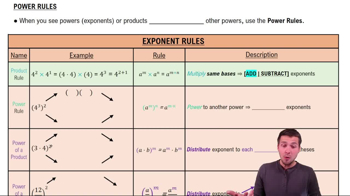Table of contents
- 0. Functions7h 52m
- Introduction to Functions16m
- Piecewise Functions10m
- Properties of Functions9m
- Common Functions1h 8m
- Transformations5m
- Combining Functions27m
- Exponent rules32m
- Exponential Functions28m
- Logarithmic Functions24m
- Properties of Logarithms34m
- Exponential & Logarithmic Equations35m
- Introduction to Trigonometric Functions38m
- Graphs of Trigonometric Functions44m
- Trigonometric Identities47m
- Inverse Trigonometric Functions48m
- 1. Limits and Continuity2h 2m
- 2. Intro to Derivatives1h 33m
- 3. Techniques of Differentiation3h 18m
- 4. Applications of Derivatives2h 38m
- 5. Graphical Applications of Derivatives6h 2m
- 6. Derivatives of Inverse, Exponential, & Logarithmic Functions2h 37m
- 7. Antiderivatives & Indefinite Integrals1h 26m
1. Limits and Continuity
Finding Limits Algebraically
Problem 2.6.55
Textbook Question
Evaluate each limit.
 Verified step by step guidance
Verified step by step guidance1
Identify the limit expression: \( \lim_{x \to \frac{\pi}{2}} \frac{\sin(x) - 1}{\sqrt{\sin(x)} - 1} \).
Substitute \( x = \frac{\pi}{2} \) into the expression to check for indeterminate form: \( \sin\left(\frac{\pi}{2}\right) = 1 \), leading to \( \frac{0}{0} \).
Apply L'Hôpital's Rule, which is used for limits of the form \( \frac{0}{0} \) or \( \frac{\infty}{\infty} \), by differentiating the numerator and the denominator separately.
Differentiate the numerator: \( \frac{d}{dx}[\sin(x) - 1] = \cos(x) \).
Differentiate the denominator: \( \frac{d}{dx}[\sqrt{\sin(x)} - 1] = \frac{1}{2\sqrt{\sin(x)}} \cdot \cos(x) \).
Recommended similar problem, with video answer:
 Verified Solution
Verified SolutionThis video solution was recommended by our tutors as helpful for the problem above
Video duration:
3mPlay a video:
Was this helpful?
Key Concepts
Here are the essential concepts you must grasp in order to answer the question correctly.
Limits
Limits are fundamental in calculus, representing the value that a function approaches as the input approaches a certain point. In this question, we are evaluating the limit of a function as x approaches π/2, which is crucial for understanding the behavior of the function near that point.
Recommended video:

One-Sided Limits
L'Hôpital's Rule
L'Hôpital's Rule is a method used to evaluate limits that result in indeterminate forms, such as 0/0 or ∞/∞. When faced with such forms, we can differentiate the numerator and denominator separately and then take the limit again, which can simplify the evaluation process.
Recommended video:
Guided course

Power Rules
Continuity and Discontinuity
Continuity refers to a function being unbroken and having no gaps at a point, while discontinuity indicates a break or jump in the function's value. Understanding whether the function is continuous at x = π/2 helps determine if the limit can be directly evaluated or if further analysis is needed.
Recommended video:

Intro to Continuity

 5:21m
5:21mWatch next
Master Finding Limits by Direct Substitution with a bite sized video explanation from Callie
Start learningRelated Videos
Related Practice







